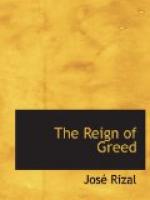But when they began to harvest their first crop a religious corporation, which owned land in the neighboring town, laid claim to the fields, alleging that they fell within their boundaries, and to prove it they at once started to set up their marks. However, the administrator of the religious order left to them, for humanity’s sake, the usufruct of the land on condition that they pay a small sum annually—a mere bagatelle, twenty or thirty pesos. Tales, as peaceful a man as could be found, was as much opposed to lawsuits as any one and more submissive to the friars than most people; so, in order not to smash a palyok against a kawali (as he said, for to him the friars were iron pots and he a clay jar), he had the weakness to yield to their claim, remembering that he did not know Spanish and had no money to pay lawyers.
Besides, Tandang Selo said to him, “Patience! You would spend more in one year of litigation than in ten years of paying what the white padres demand. And perhaps they’ll pay you back in masses! Pretend that those thirty pesos had been lost in gambling or had fallen into the water and been swallowed by a cayman.”
The harvest was abundant and sold well, so Tales planned to build a wooden house in the barrio of Sagpang, of the town of Tiani, which adjoined San Diego.
Another year passed, bringing another good crop, and for this reason the friars raised the rent to fifty pesos, which Tales paid in order not to quarrel and because he expected to sell his sugar at a good price.
“Patience! Pretend that the cayman has grown some,” old Selo consoled him.
That year he at last saw his dream realized: to live in the barrio of Sagpang in a wooden house. The father and grandfather then thought of providing some education for the two children, especially the daughter Juliana, or Juli, as they called her, for she gave promise of being accomplished and beautiful. A boy who was a friend of the family, Basilio, was studying in Manila, and he was of as lowly origin as they.
But this dream seemed destined not to be realized. The first care the community took when they saw the family prospering was to appoint as cabeza de barangay its most industrious member, which left only Tano, the son, who was only fourteen years old. The father was therefore called Cabesang Tales and had to order a sack coat, buy a felt hat, and prepare to spend his money. In order to avoid any quarrel with the curate or the government, he settled from his own pocket the shortages in the tax-lists, paying for those who had died or moved away, and he lost considerable time in making the collections and on his trips to the capital.
“Patience! Pretend that the cayman’s relatives have joined him,” advised Tandang Selo, smiling placidly.
“Next year you’ll put on a long skirt and go to Manila to study like the young ladies of the town,” Cabesang Tales told his daughter every time he heard her talking of Basilio’s progress.




